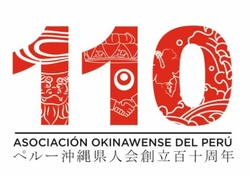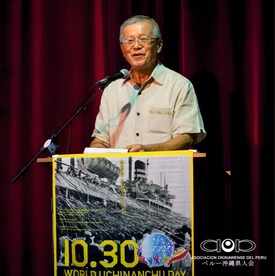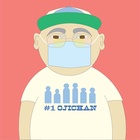In 1906, immigrants from Okinawa arrived in Peru for the first time. Four years later, they formed what is now the Okinawan Association of Peru (AOP).
The coronavirus pandemic has ruined the possibility of celebrating the 110th anniversary as it deserves. That does not mean, however, that its managers and members have stood by and waited for the health crisis to be resolved or mitigated before acting.
The AOP did not paralyze its activities due to the restrictions derived from the quarantine imposed by the Peruvian government to stop the spread of the virus. On the contrary, it has reinvented itself by providing food and cleaning product delivery services so that people can receive them at home, and thus avoid going out on the street and the subsequent risk of becoming infected.
THE OLDEST NIKKEI INSTITUTION
The AOP was born on the same day of Peru's independence, July 28. Its first president and great promoter was Sentei Yaki, a central character in the history of Japanese immigration in its beginnings.
Yaki introduced tanomoshi to Peru and extended a providential hand to many immigrants in difficulty—due to labor exploitation, illnesses, cultural barriers, etc.—in the country.
Helpless in a country whose language and customs they did not know after fleeing farms where they suffered mistreatment, hit by diseases such as malaria, Yaki housed homeless immigrants, found them jobs, took them to hospitals and, if unfortunately they did not survive, buried them.
This Okinawan — a man “endowed with an enormous humanitarian spirit,” according to the book Walking 75 Years on the Roads of Peru , edited by Samuel Matsuda — understood that immigrants needed to organize to get ahead and advocated for the formation of an institution that would bring together the Okinawans.
The current president of the AOP, Jorge Yamashiro, remembers that the institution was founded to “provide help and guidance to the Okinawan community, in the economic aspect, as well as legal advice, in addition to being able to revive the music and dances of Okinawan, among others. other manifestations and customs.”
One of the peculiarities of the Nikkei community in Peru is that the majority of its descendants have ancestors in Okinawa.
The AOP, the oldest Nikkei institution in Peru, has accompanied and contributed to the roots of the community of Okinawan origin in the country, its fight against adversity during the tumultuous period marked by the Second World War, and its reconstruction and growth in the postwar. In the 1980s, it established a milestone with the inauguration of its institutional headquarters, which was made possible by its leaders and associates, as well as the support of Okinawa Prefecture and Nikkei institutions.
SURVIVAL IN DIFFICULT TIMES
The AOP premises have soccer fields, swimming pool, auditorium and restaurant, among other facilities. Since its opening, several generations of Nikkei have passed through it to practice sports, carry out cultural and artistic activities, socialize, live institutional life, participate in matsuris, etc.
Until the pandemic arrived. In March, Peru abruptly went into total recess. As organizations did in all countries where strict confinements were established, the AOP moved from in-person meetings to virtual ones through Zoom.
What to do in this unprecedented scenario? What alternatives did the association have if everything was prohibited except essential tasks? From there came the answer: what is essential. A society can temporarily deprive itself of cinema, football, shopping malls, tourism, etc., but not of eating.
The staff of the institution, with the leadership of the general manager, Roberto Higa, acted quickly to launch the home delivery service for everyday consumption items, especially food.
The Junji Nishime auditorium, the epicenter of cultural and institutional activities, little by little was transformed into a “large, perfectly organized logistics warehouse, with all the required security protocols,” says Jorge Yamashiro.
“Our work staff, made up of 24 people (all with a lot of kimochi uchinanchu) enthusiastically aligned themselves with the venture, and Roberto (Higa) was planning and organizing, placing each of them, according to their knowledge and skills, in each one of the stages properly, in order to make the machinery work,” he reveals.
The association's delivery service began at the dawn of the quarantine, when this type of sale was not yet widespread in Lima or was slow due to logistical difficulties.
“Delivery sales have been the lifeline to be able to comply in some way with the commitments that the AOP maintains,” says Eng. Yamashiro.
The service has not only saved the institution. It has surely also saved members of the Nikkei community from falling ill. At the beginning of the state of emergency in Peru, the markets and supermarkets, with restricted hours and shortages of certain items, were full of people or the lines to enter seemed miles long, so the risk of contagion was high.
In the AOP delivery sale, businesses from the Nikkei community have also found a lifeline. “Always thinking about the philosophy of our founder, that of practicing mutual aid, Nikkei producers and farmers were called together, with the intention of marketing their products. Likewise, on the issue of delivery, we contacted Nikkei school service transporters, with their help to complete the virtuous circle of mutual aid,” explains the president of the organization.
The service is expanding gradually. At first, it offered basic items such as rice and vegetables. Today, it also markets Japanese products, such as soba , ashitibichi , awase mochi , onigiri , tenpura , kamaboko , etc.
The AOP initiative is part of a community of efforts that the Nikkei in Peru are deploying in an organized manner. The Peruvian Japanese Association, at the head of a group of Nikkei organizations, has created the Peru Ganbare campaign to help the sectors hardest hit by the crisis.
This spirit of mutual support and solidarity, instilled by Japanese immigrants, is reinvigorated in these times of crisis. “With great pleasure we see that the guardian institutions of our Nikkei community, each within their scope, are putting into practice cooperation, mutual aid, giving support to those most in need,” highlights Jorge Yamashiro.
“Increasingly, we must reaffirm our commitment to the country,” he adds. Commitment to a country that offered our ancestors the opportunity to build a new life and prosper.
“SOLIDARITY BOARD”
Although the community of Okinawan origin in Peru is commemorating the 110 years of creation of its parent institution and not the arrival of the first immigrants, the organizations are founded and are made up of people.
Thus, the AOP anniversary is also a reason to remember the Okinawans who crossed the Pacific to work in Peru. Like Jorge Yamashiro's parents.
“We lived in Callao—on a corner, in front of the central market—.My parents had a warehouse business, selling groceries and Japanese products and foodstuffs. Our store was one of the main points of sale where most Japanese and Nikkei people from Callao went, including many who lived in Hacienda San Agustín,” he recalls.
The memory of his parents brings about a form of mutual aid that was crucial for the development of the Nikkei community and whose spirit endures to this day: tanomoshi.
The parents of the president of the AOP organized tanomoshis. They received relatives and friends at monthly meetings that were held in the back room. For the Japanese colony, these encounters were much more than mere economic interactions; They constituted spaces for socialization and fraternity.
Jorge Yamashiro remembers that in his parents' tanomoshis they talked about a myriad of issues—from the family to the institutional. Likewise, they served to “initiate a broad exchange of conversations, consultations, advice and opinions on various everyday topics; “It surely also served to arrange probable future marriages.”
At the beginning of the tanomoshi —“a solidarity meeting,” as it was well defined in the book The Future Was Peru , by Alejandro Sakuda—, Okinawan immigrants who worked as waiters, hairdressers' assistants or dishwashers managed to form capital that made it possible that they created their own businesses, a great qualitative leap in the life of the Issei. Thanks to Sentei Yaki, founder and first president of the AOP.
© 2020 Enrique Higa Sakuda










